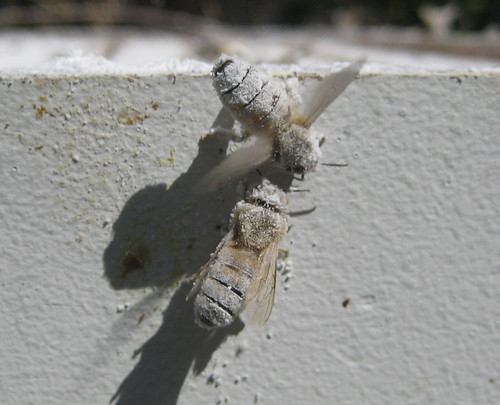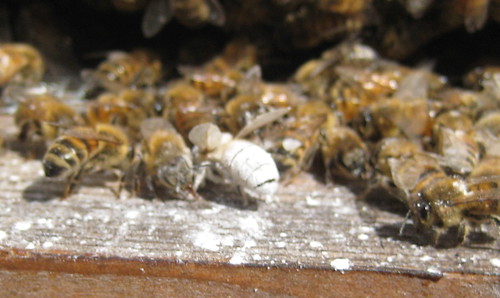The hive looked to be in good shape and the honey super that we still have remaining is nearly full, though they have not started capping they honey yet. The top hive body was about 2/3 full of honey and a little pollen and the remainder in the center had healthy looking brood in all stages of development. We did see some eggs which is important since that indicates that the queen has been laying within the last three days. We did not see Agnes herself, but that is not surprising since we didn't pull out most of the frames -- just enough to get an idea of how much brood there was vs, food supplies.
We pulled a couple frames out of the lower hive body and sure enough there is quite a bit of brood down there as well. The lower hive body seemed to all be sealed brood -- but I did notice a few cells that were open, yet had underdeveloped chrysalises. I'll have to read up and see if I can figure out if that means anything. It didn't look like foulbrood of any kind or chalkbrood, and in the same frame we found three bees that were just emerging from their cells so I am not worried.
Finally before we started putting the boxes back on the hive, we dusted each layer liberally with powdered sugar. Sprinkling about 1/2 cup on the tops of the frames of each box, we used the bee brush to scatter the sugar down between the frames over all the bees before adding the next box on top of it.
 No, we don't think that the honey or the princesses themselves are not sweet enough. But this is an organic method of keeping the mite population at bay. The sugar dusting makes it harder for the mites to hold on to the bees. It also makes the bees groom themselves. The combination allows the bees to knock the mites off of themselves so they fall to the bottom of the hive. We use a screened bottom board so the mites fall right out of the hive where they can't reach the bees to get back in.
No, we don't think that the honey or the princesses themselves are not sweet enough. But this is an organic method of keeping the mite population at bay. The sugar dusting makes it harder for the mites to hold on to the bees. It also makes the bees groom themselves. The combination allows the bees to knock the mites off of themselves so they fall to the bottom of the hive. We use a screened bottom board so the mites fall right out of the hive where they can't reach the bees to get back in. 
This is not a perfect method, but it does not resort to chemical pesticides which the mites may become resistant to or which may harm the bees and contaminate the hive and its products (read: honey, wax, propolis).
While we can't call our honey organic, because there is no way for us to control where the nectar is collected and there may be fertilizers or other chemicals used on the flowers the bees visit, we can make sure that we provide the bees with only natural, chemical free care and and clean naturally maintained hive.
 Later in the afternoon while I was in the back yard, I noticed that the ivy growing over the neighbors' fence was covered with bees (it is just now blooming teeny green flowers). I went to watch them and saw one with her back still covered with white powder -- one of the princesses had made it to our own backyard for a visit!
Later in the afternoon while I was in the back yard, I noticed that the ivy growing over the neighbors' fence was covered with bees (it is just now blooming teeny green flowers). I went to watch them and saw one with her back still covered with white powder -- one of the princesses had made it to our own backyard for a visit!  Pardon the poor photo.
Pardon the poor photo.Please visit our shop to purchase Noe Valley Honey and other hive products from the Pollen Princesses.



No comments:
Post a Comment